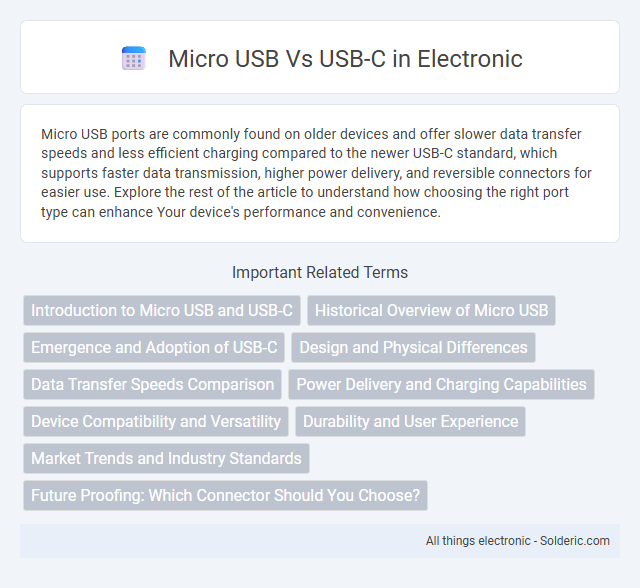Micro USB ports are commonly found on older devices and offer slower data transfer speeds and less efficient charging compared to the newer USB-C standard, which supports faster data transmission, higher power delivery, and reversible connectors for easier use. Explore the rest of the article to understand how choosing the right port type can enhance Your device's performance and convenience.
Comparison Table
| Feature | Micro USB | USB-C |
|---|---|---|
| Connector Shape | Small, flat, one-sided | Oval, reversible, symmetrical |
| Reversibility | Non-reversible | Reversible |
| Data Transfer Speed | Up to USB 2.0 (480 Mbps) | Supports USB 3.1, 3.2, and USB4 (up to 40 Gbps) |
| Power Delivery | Up to 2.5W (5V, 0.5A) | Supports USB Power Delivery up to 100W (20V, 5A) |
| Usage | Older smartphones, tablets, some peripherals | Modern smartphones, laptops, tablets, peripherals |
| Durability | Less durable, wears faster | More durable, higher insertion cycles |
| Video Support | No native support | Supports DisplayPort and HDMI alt mode |
| Adoption | Legacy, declining | Widely adopted, industry standard |
Introduction to Micro USB and USB-C
Micro USB, introduced in 2007, became the standard for charging and data transfer in many devices due to its compact design and compatibility with older electronics. USB-C, launched in 2014, offers faster data transfer speeds, higher power delivery, and a reversible connector that enhances user convenience. Understanding the distinctions between Micro USB and USB-C is essential for optimizing your device connectivity and charging efficiency.
Historical Overview of Micro USB
Micro USB emerged in the mid-2000s as a universal charging and data transfer standard, widely adopted in smartphones, tablets, and other portable devices due to its compact size and compatibility. It replaced a myriad of proprietary connectors, standardizing cables and chargers across manufacturers for increased convenience. Your devices that were launched before the widespread adoption of USB-C likely rely on Micro USB for power and connectivity, highlighting its historical significance in mobile technology development.
Emergence and Adoption of USB-C
USB-C emerged as a revolutionary connector with faster data transfer speeds up to 10 Gbps and enhanced power delivery compared to Micro USB's 480 Mbps and limited power support. Major tech companies rapidly adopted USB-C for smartphones, laptops, and peripherals, driven by its reversible design and universal compatibility. Your devices benefit from this widespread adoption through improved charging efficiency and simplified connectivity across a growing ecosystem of USB-C enabled hardware.
Design and Physical Differences
Micro USB features a smaller, trapezoidal design with a top and bottom orientation, requiring precise alignment for connection. USB-C boasts a reversible, oval shape that allows for seamless plugging in either direction, enhancing user convenience. Your device compatibility will depend on the port design, with USB-C supporting faster data transfer and higher power delivery due to its advanced physical attributes.
Data Transfer Speeds Comparison
Micro USB typically supports USB 2.0 speeds with data transfer rates up to 480 Mbps, limiting performance for large file transfers. USB-C connectors, especially those compliant with USB 3.1 or USB 3.2 standards, offer significantly faster speeds ranging from 5 Gbps to 20 Gbps, enabling efficient handling of high-bandwidth tasks. Devices with USB-C ports benefit from enhanced transfer speeds, supporting modern applications like 4K video streaming and rapid charging technologies.
Power Delivery and Charging Capabilities
USB-C supports higher power delivery with up to 100W compared to Micro USB's typical maximum of 15W, enabling faster charging for larger devices like laptops and tablets. USB-C also supports USB Power Delivery (USB PD) protocols, allowing dynamic voltage and current adjustments for optimized charging efficiency. Micro USB is mostly limited to slower charging and does not support advanced power negotiation, making USB-C the preferred choice for modern devices requiring rapid and flexible charging solutions.
Device Compatibility and Versatility
USB-C offers superior device compatibility compared to Micro USB, as it supports a wider range of modern devices including smartphones, tablets, laptops, and peripherals with reversible connectors for easier use. Micro USB remains common in older devices like budget smartphones and some accessories but lacks the versatility of USB-C's faster data transfer, power delivery, and video output capabilities. Choosing USB-C enhances your ability to connect across diverse gadgets with improved convenience and future-proof functionality.
Durability and User Experience
USB-C offers enhanced durability compared to Micro USB due to its robust, reversible connector design that reduces wear and tear from repeated plugging and unplugging. The reversible nature of USB-C significantly improves user experience by allowing easy, error-free connection without orientation concerns, unlike Micro USB which requires careful alignment. Furthermore, USB-C connectors are built to withstand up to 10,000 insertion cycles, nearly double the lifespan of Micro USB connectors, making them a more reliable and user-friendly option.
Market Trends and Industry Standards
USB-C is rapidly becoming the dominant industry standard, driven by its superior data transfer speeds, power delivery, and reversible design, which are widely adopted across smartphones, laptops, and peripherals. Market trends show a steady decline in Micro USB usage, especially as regulatory bodies like the EU mandate USB-C for universal charging to reduce electronic waste. Leading technology manufacturers are transitioning to USB-C to ensure compatibility, future-proofing devices, and meeting evolving consumer expectations in a highly competitive market.
Future Proofing: Which Connector Should You Choose?
USB-C offers superior future-proofing due to its reversible design, faster data transfer rates, and widespread adoption in modern devices compared to Micro USB. Choosing USB-C ensures compatibility with emerging technologies such as USB4 and Power Delivery standards, providing enhanced charging efficiency and versatility. Your investment in USB-C accessories guarantees longer usability and better support for future gadgets.
Micro USB vs USB-C Infographic

 solderic.com
solderic.com